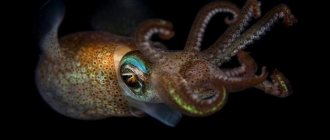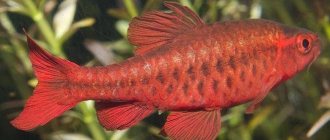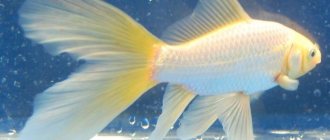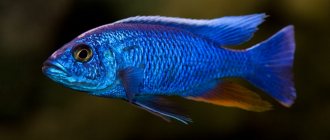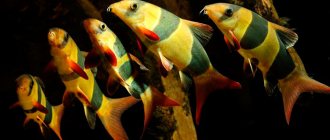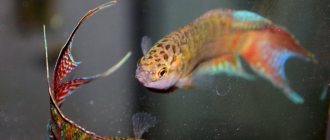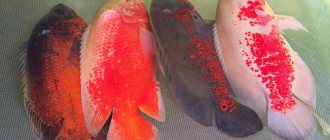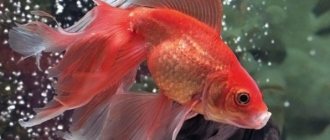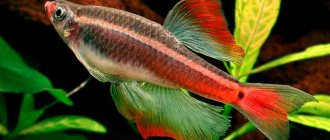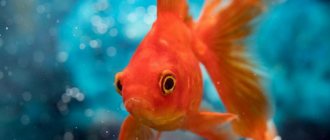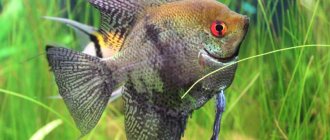The diet of bots in nature is extensive. In fact, they eat everything - insects, larvae, worms. For an aperitif, they can chew a stretchy drink. Therefore, in aquarium conditions, their feeding should be varied and contain both protein and plant ingredients. Bots will calmly pick up any food that reaches the bottom - flakes, granules, sticks. But if we talk about personal feeding, it is best to use tablet food, such as Tetra Wafer Mix.
Food for bots from Tetra
Please note that it is not worth buying food tablets for loriks , such as Tetra Pleco Tablets. Such food consists entirely of plant ingredients. The boys will not approve of such a choice.
Description and natural habitat
Botia belong to the Convolvulus species of fish that inhabit the waters of Indochina and Asia.
The long body resembles a torpedo with a triangle in cross-section. The belly is flat, the pointed snout-shaped head with a lower mouth and three to four pairs of whiskers is large, with expressive eyes.
Botsia has a number of features. For example, these are sharp spines that hide in special sinuses near the eyes. In a moment of danger, they jump out with a sharp click, reminiscent of a knife flying out of the handle, and pose a serious threat to the attacking enemy. Often, when transporting fish in plastic containers, this is what causes the integrity of the packaging to be compromised.
In the area of the pelvic and pectoral fins there are special suction cups, with the help of which Botsia is fixed at the bottom of the reservoir in order to scrape off vegetation from it - mosses, algae, young shoots.
The dorsal fin is short, but very high and looks like a crest with clearly visible rays, because Convolvulaceae are ray-finned fish. The large tail consists of two parts, stands vertically and is equal in height to the same body parameter.
The characteristic biotopic type of fish habitat in India, China, Pakistan, Borneo and Sumatra are small streams with a silted bottom overgrown with vegetation.
Photo gallery of different Botsiya fish:
The body size depends on the species and can be from 5 to 35 cm. The coloring is also varied, usually very bright and festive.
In nature, they lead a twilight and nocturnal lifestyle. Always stay in a small flock near the bottom of the reservoir in search of food. Only a few subspecies are known, for example, Marbled, which hunt at any time of the day and are not afraid to swim during the day. They prefer plant foods, but in principle they are omnivores; they also eat snails, other mollusks, and invertebrates.
If Botsia is full, then it moves slowly, lazily, but at the same time it is always attentive; in a throw it is a very fast fish. When in danger, it can pretend to be dead, turning over on its belly. These pets also sleep, thereby frightening their owners.
They click not only when attacking, but also when begging for tidbits and playing. Quite noisy underwater inhabitants.
Depending on the type and size, life expectancy is from 4 to 10 years; long-lived specimens are known (20 years).
In artificial reservoirs they behave noisily and aggressively, but irritation is most often distributed among their fellows. Therefore, it is important to quickly form a flock so that a hierarchy is established in it. However, it is a territorial species, fiercely defending its habitat.
It is very difficult to distinguish a male from a female. The female becomes slightly thicker during the mating season. It is difficult to reproduce in captivity; in natural conditions, during spawning, they swim enormous distances to select a reservoir with the necessary hydrochemical composition.
Some species of especially large sizes are the object of fishing among local residents.
Description
The aquarium fish Botsia maracantha was discovered in Indonesia back in 1852, then its full description was given by the famous biologist Blekker. This fish attracted the scientist’s attention with its bright colors, so very soon the botia migrated to artificial reservoirs of the countries of the Old World, and from there it spread to Russia.
Botia is a large fish; in its natural environment it grows up to 40 cm, but in artificial reservoirs it is half that size. The length of an adult is approximately 20-25 cm. There is no obvious sexual dimorphism; only specialists can distinguish a male from a female, and then only during the period when the fish becomes sexually mature.
The body is elongated, compressed on the sides, and mustaches are located near the mouth, usually hanging down. Under the eye sockets there are spines that serve as protection from aquatic predators. In the normal state they are hardly noticeable, since they are covered with a dense leathery sac, but under stress and in moments of danger they quickly come out. It lasts no more than a second. However, extreme care must be taken when catching fish - the spikes can become entangled in the net and this will harm the fish.
It is best to use plastic containers for catching.
The bots look very impressive, they have bright and rich colors: three dark contrasting stripes are visible on a yellowish-red background, the tail and lower fins are bright red, which makes it even more decorative. Young individuals look especially colorful.
When favorable conditions are created, bots in captivity can live quite a long time - up to 20 years. Over the years, the color loses its brightness a little, but even the pale aquatic inhabitants look very beautiful.
Boots are popular not only because of their appearance. The behavior of the fish is also of great interest. Agree, not every aquarist can calmly watch how his pet floats belly up, and the loaches sleep in a similar position. They also love to rest on their sides, mainly at the very bottom of the aquarium. If you are not aware of such fish manners, then these pranks can seriously frighten its owner.
Mr. Tail recommends: variety of types of bots
There are not very many known varieties in the official classification, but this is a fairly young fish in the aquarium hobby. Every year new types are discovered and selective breeds are created. So the systematization of Bots is in development.
Boots Morleti
Other names for these fish are Ribbon, Chora, Skunk. They live mostly in the waters of Thailand.
The long elongated body reaches 10 cm. It has a brownish background, on which rare spots are scattered a tone darker or yellowish. A black line stretches from the upper lip through the head and dorsal fin, turning into a wide black ring at the base of the caudal fin. This color remains unchanged throughout its life and allows Morleti to camouflage well on the sandy bottom.
At home, it is better to keep a flock of 10 individuals in large tanks with a flowing current. In this case, they behave quite calmly towards other underwater inhabitants, if they do not occupy the bottom area.
Needs warm, slightly acidic or neutral soft water with a temperature of +24…+30 °C. Reproduction is difficult; juveniles are purchased from fish farms in Asia.
Bradmore or Royal boots
Syncrossus berdmorei lives in Thailand and Myanmar (Irrawaddy, Atiaran, Suyang, Salween rivers).
This Botsia has a truly royal coloring. On a long and strong body (up to 15 cm), the main background is ocher-golden or chocolate and red fin plumage, along which black markings are scattered. The same oval spots run in horizontal rows along the entire body, and wide stripes cross it across it. The back is high and convex, the stomach is smooth and flat.
Noisy, strong, active fish, jumps well, the tank must be covered with a lid. For quiet keeping, a flock of at least five individuals is needed. The water can be cooler +21…+25 °C, neutral and soft.
Home breeding is difficult. It is bred for commercial purposes on Asian farms.
Pulcher Boots
Sinibotia pulchra is often called the Golden Zebra due to its yellow background and dark transverse stripes. When kept at home, it rarely reaches 8 cm; a flock should contain 6-8 individuals in an aquarium with a large volume. Prefers soft and slightly acidic water with a temperature of +19…+24 °C. Cases of breeding offspring by amateurs have not been recorded.
Tiger Boots
Syncrossus hymenophysa naturally lives in streams and rivers of Malaysia, Sumatra, and Borneo. Large fish - up to 25 cm long. The scales are colored pinkish-golden; wide transverse stripes (10-13 pieces) run across the main background, a tone darker with a greenish edging. The fin plumage is red, with black markers on the high dorsal fin.
This species is rarely found in home aquariums, since a group of five individuals requires a tank with a volume of at least 600 liters. As a last resort, you can keep one Tiger Botia, but without any neighbors, since this type is quite aggressive. In a flock, the cocky nature is extinguished by intraspecific conflicts, and the pets become calmer.
Such a bright color appears only in adults from 12 months; fry and juveniles are faded and gray.
They love warm water around +30 °C with a high oxygen content, light bottom current and good filtration.
For successful reproduction, hormonal drugs are needed; breeding at home is problematic.
Boots Dario
Other names are Geto, Royal Char, Bengal Botia, as it mostly inhabits the Brahmaputra and Ganges rivers of the Indian state of Bengal.
In their natural habitat they grow up to 15-20 cm, but in an artificial reservoir they rarely reach 7-8 cm.
Getos are bee-like with wide transverse stripes alternating brown (or blue) and yellow. The same markers are on the large two-lobed caudal fin.
Very bright and beautiful fish, but the color fades as they age.
Young animals usually hide in shelters all day, emerging to hunt only at night. Adults in the flock behave peacefully and calmly move around the tank all day. The larger the group, the more interesting it is to watch Dario - some kind of conflicts constantly break out there over food or resting place, but they do not turn into a fight, but are limited to pushing and pinching fins.
You need soft and neutral water with a temperature range of +22…+24 °C.
This species is also bred on specialized farms using hormones.
Boots Lecomte
Lives in small rivers of Laos, Thailand, Malaysia, Vietnam. Another name is Silver Loach. The fish sizes are 15-17 cm.
Botia lecontei has a convex dorsal part of a greenish-gray color, the sides with purple reflections. The plumage is bright - almost orange with a dark mark on the tail. Usikov - three pairs.
This is a shy fish, but its territorial nature makes it protect its habitat. It shows little during the day; it prefers to lead a twilight, bottom-dwelling lifestyle.
Zebra Boots
They are also called Striped Botia striata. It lives mostly in Indian reservoirs - the Tunge and Shivamagga rivers. The natural population has been greatly reduced today.
The Zebra has a very bright color - there are dark transverse stripes on the silver body, and a golden flat belly.
The fin plumage is almost transparent, but there are dark strokes on it.
Natural specimens grow up to 12-13 cm, but in home aquariums body sizes rarely reach 7-8 cm.
The zebra is peaceful in a flock of 6-8 individuals.
Dwarf Botia
Yunnanilus cruciatus are also called Yunnanilus Cruciatus, Vietnamese Botia, Multi-striped Loach, and Dwarf Zebra. Mostly found in nature in Southern Vietnam, found in quiet creeks, ponds, and lakes.
The body size when kept in aquariums is about 3.5 cm. The scales are golden, and light brown wide ribs run across the body.
A thin, barely visible stripe may appear from eye level to the caudal fin.
Boots Modest or Blue
Yasuhikotakia modesta is perhaps the most common species in the aquarium hobby.
In nature, this large (up to 25 cm) fish is found in the reservoirs of Thailand (the Chau Phraya, Lop Buri, Pa Sak, Mekong rivers), as well as in Laos, Cambodia, and Vietnam.
The main background is gray-blue, in dim light it becomes bright blue. The fin plumage is striking with an orange sheen.
Loves clean, soft, neutral water with good oxygen saturation and a temperature of +23...+28 °C. It is better to keep them in a flock with a minimum number of five individuals.
Macracanthus or Clown Boats
Botia Chromobotia macracantha is very widely known and loved by aquarists for its cheerful character and spectacular color. Endemic species of Sumatra.
On the strong orange body there are rare bright dark stripes of varying width, they taper towards the abdomen, there are three or four of them.
Large individuals, usually 15-20 cm, but cases of 40 cm specimens are known. They need large aquariums, since the flock must have at least five members. In this case, the fish are engaged only in intra-group relationships and do not show aggression towards other inhabitants of the tank.
Water is needed at a temperature of +24...+30 °C, slightly acidic and soft, with good aeration and filtration.
It is difficult to reproduce in artificial reservoirs; only isolated cases are known, produced with the help of hormonal therapy. Commercial samples are sold from Asian fish farms.
Boots Kubotai
These fish are also called Checkerfish. A relatively new species, described only in 2004. Homeland - Thailand and Myanmar, the Salween, Suriya, Kaya rivers.
Natural specimens reach 14-18 cm, and in an aquarium their average size is 7-10 cm. The long body with a convex back and flat belly is covered with spots of various shapes of light and chocolate shades. The color really does look a bit like a chessboard. There are also rare black and bluish stripes. All fin plumage is the same color.
This is a very peaceful, cheerful fish, which, when kept in a school, calmly and treats any neighbors well. Unlike other species, these pets are active during the daytime.
There are no cases of breeding at home yet.
Reticulated Botsia or Lochacta
Botia sidthimunki or Nosy Dei are small, up to 5-7 cm, fish from the reservoirs of Northern Thailand, India, and Pakistan.
The main background is silver, with dark lines scattered across the body, reminiscent of a grid in arrangement. The same markers are on the translucent fin plumage.
A shy and peaceful fish, it needs to be kept in a school. For 6-8 individuals, a 150 liter tank is enough. Prefers to lead a daytime bottom lifestyle.
With the use of gonadotropic injections, professionals have recently mastered aquarium breeding of this species.
Baya boots
Botia Iucas Bahi - Thai Botia, a small bottom-dwelling schooling fish. In an aquarium it grows up to 7-8 cm.
Its color contains gray, yellow and brown tones with a blue tint. Numerous strokes and dots and not very bright transverse stripes are scattered across the main background.
Nocturnal inhabitants of the reservoir, they hide in shelters during the day.
Fighters of the Rostrata
Botia rostrata is found in rivers, lakes, creeks and ponds in India and Bangladesh.
In artificial reservoirs their average size is 7-9 cm. The main background is pale gray with streaks a tone darker. Translucent fins are colored similarly.
This fish is also called Long-snouted and Two-ribbon, when kept in schools (6-8 individuals) - these are peaceful twilight bottom inhabitants.
Reproduction at home has not yet occurred.
Histrionics bots
Botia histrionica lives mostly in its natural habitat in the Irrawaddy River in Burma, as well as in the Chinese province of Yunnan.
This is one of the few varieties of Botsia that prefers a diurnal lifestyle; at night the fish sleeps in shelters.
There are dark wide transverse stripes on the silver body. In places they intersect, forming a pattern similar to a beech Y.
When kept in aquariums in schools, they reach sizes of 10-13 cm.
At a young age, the color is bright and saturated, brown and yellow colors predominate in it; closer to old age, the fish turns pale, the patterns are distorted.
Almora or Marble botsia
Botia almorhae naturally live in rivers, ponds, and lakes in India, Pakistan, Bangladesh, and Nepal. They are often called Pakistani Boots.
The main background of the body is light, silver, dark stripes are scattered in such a way that they resemble marble veins.
This fish was discovered relatively recently and is also a rare species of daytime bottom dwellers.
When kept in a school in an aquarium, they grow up to 13-15 cm and require a large tank.
They thrive in a wide temperature range of +19…+28 °C, in soft, neutral and clean water with a high oxygen content.
Reproduction at home has not yet been recorded.
Emperor boots
Botia emperor or Imperial reaches a length of 13-15 cm. In nature, it lives in Thailand and Myanmar. The fish was first discovered only in 1993, and the species was described in 2007.
The main background is yellowish-olive, double dark transverse stripes run throughout the body, and there are also rare dotted markings. Translucent fin plumage of the same color.
Peaceful twilight schooling underwater inhabitants. It has not yet been possible to obtain offspring at home.
Kinds
Clown botia (Botia Chromobotia macracantha)
The most famous species from the Bots family. In aquariums it grows up to 15-20 cm. The body color is represented by wide alternating black and orange vertical stripes. Sexual dimorphism is not expressed. When kept alone, it can show aggression, so a flock of at least 5 individuals is recommended. For such a number of fish, you need an aquarium of at least 350 liters and high-quality filtration, but without a strong current. The best soil is small pebbles or sand. Gets along well with large-sized fish. It can bite the long fins of its neighbors. It is advisable to create a large number of shelters from stones and driftwood in the aquarium. Reproduction in an aquarium is difficult; hormonal injections are required. It feeds on food for bottom fish, frozen motel and brine shrimp, and is good at eating small mollusks (for example, melania). It is necessary to add food with a plant component, otherwise the bots can damage living plants in the aquarium.
Optimal parameters for content:
temperature – 24–30°C pH = 5.0–7.0 water hardness – soft (2–12 dGH).
Marbled botia (Botia almorhae)
The fish is medium in size, the body length usually does not exceed 15 cm. The body color is marbled: on a light background there is a dark pattern of irregular stripes. Sexual dimorphism is not expressed. An aquarium from 200 liters is suitable for keeping. The best soil is mixed - sand + pebbles. It is recommended to install stones and driftwood in the aquarium, overgrown with ferns and mosses. As inhabitants of natural flowing water bodies, these fish love high quality water. It is not recommended to create a strong current; very bright light is also undesirable.
It is best to keep marble bots in groups of 5 or more (there should be both males and females). When living in smaller numbers, aggressiveness towards relatives and other inhabitants of the aquarium sharply increases. Small fish with well-developed veil fins will not be the best neighbors for bots - they can easily bite the fins of other fish. The species is not picky in its diet: special tablets for bottom fish (especially those with a high content of spirulina) are well eaten.
Optimal parameters for content:
temperature – 19–27°C pH = 5.5–7.5 water hardness – soft (2–12 dGH).
Marbled botia (Botia almorhae)
Botia Modesta (Yasuhikotakia modesta)
One of the best candidates for keeping in a community aquarium. They have a calm character. The maximum size is up to 25 cm. It has a gray-blue body, which, if well maintained, can acquire a bright blue tint. The fins and tail are orange in color. Sexual dimorphism is not clearly expressed; it is difficult to identify females. It is best to keep them in flocks of 5 or more. When kept alone, Modest's bots can conflict with neighbors and bite off veil fins. For a minimum flock, an aquarium of 200 liters with sandy soil is required. You should not install bright lighting; it is better to choose shade-tolerant plants. The water should be well oxygenated and clean. Good filtration and weekly water changes are mandatory.
The diet is dominated by food of animal origin. The best option would be high-quality tablet food for bottom fish. Natural reproduction without the use of hormonal drugs is difficult.
Optimal parameters for content:
temperature - 23–28°C pH = 6.0–8.0 water hardness — soft (2–12 dGH).
Botia Modesta (Yasuhikotakia modesta)
Botia morleti
This fish can also be found under the names Ribbon botsia and Skunk botsia. She received this name for her special coloring. The main body color is white with a golden tint. Juveniles have dark vertical stripes all over their bodies; in adult fish, only one remains, running along the entire back, and a kind of “belt” is formed around the caudal fin. Botia does not have a bright appearance, but is quite simple to maintain.
In good conditions, the fish grows up to 7-8 cm. It is difficult to distinguish a female from a male. An aquarium of 100 liters or more is required for maintenance. It is optimal to use sand or small rounded pebbles as soil. Shelters made of stones and driftwood are necessary; it is advisable to also place shade-tolerant plants (Java moss, anubias, etc.) in the aquarium. Botia are quite active fish and are able to jump out of the aquarium, so it is necessary to cover it with a lid.
The optimal number of bots for keeping will be 10 individuals (minimum 5). The fish has a calm character and will get along with most fish without problems. It is not recommended to plant with fish of a similar size that occupy the lower layers of the aquarium (for example, corydoras), conflicts are possible.
Reproduction without the use of hormones is impossible.
Optimal parameters for content:
temperature – 23–28°C pH = 6.0–7.5 water hardness – soft (2–12 dGH).
Birdmore's botia (Syncrossus berdmorei)
The fish have a very interesting coloring: there are a number of uniform dark stripes on a yellow background. In young individuals, black spots can be observed, which disappear as they grow older. The tail and other fins have a reddish tint. The fish is often called a tiger bot. In aquariums, Beardmore's botia grows up to 25 cm, so for a minimum flock of 5 individuals an aquarium of at least 300 liters is required. The soil should not contain sharp stones; it is best to use sand or small pebbles. A large number of shelters is welcome. Driftwood overgrown with ferns and mosses looks very good in an aquarium.
Not compatible with small fish or those with long veil fins (cockerels, goldfish, etc.). Feeding is easy and sinking spirulina tablets are a good choice. Natural reproduction in an aquarium is impossible, since it is difficult to recreate natural spawning conditions: seasonal migrations with changes in hydrochemical water parameters. Botsia is bred on special farms using hormonal injections.
Optimal parameters for content:
temperature - 21-26°C pH = 6.5-7.5 water hardness - soft and medium hard (5-15 dGH).
Birdmore's botia (Syncrossus berdmorei)
Botia Pulchra (Sinibotia pulchra)
This fish can be found on sale under the name “golden zebra” botia. Unpretentious and peaceful, perfect for keeping in general aquariums. The color is “tiger” - alternating wide yellow and brown stripes. The size in the aquarium is 8-10 cm. There are practically no external sexual characteristics. They must be kept in flocks of 3-4 individuals. The minimum volume of the aquarium is from 100 liters. Sandy soil is a good choice. Don’t forget about the various shelters and islands of vegetation. They eat all types of food with pleasure. The more varied the diet, the better. Their lifestyle is secretive, but they always come out while feeding. It is not possible to obtain natural offspring in an aquarium.
Optimal parameters for content:
temperature - 20-25°C pH = 6.5-8.0 water hardness - soft and medium hard (5-15 dGH).
Tiger botia (Syncrossus hymenophysa)
This botia is much less common in amateur aquariums. This is due to the fact that the fish has a cocky character and is capable of offending many neighbors in the aquarium. The average size in an aquarium is 15-20 cm, females are larger than males. The body color of an adult botia is yellow with 10-13 transverse stripes of dark blue; the abdominal part is strewn with numerous spots. Juvenile coloration is different: juvenile tiger bots are gray in color.
It is best to keep them in flocks of 5-6 pieces in an aquarium of 300 liters or more. It is important to remember that when there is a shortage of territory, conflicts between relatives are inevitable. The soil must be sandy and a large number of shelters must be installed. In an aquarium, tiger bots eat well bottom food with plant concentrate. Forced aeration is required. The fact is that tiger borers prefer warm water up to 30°C; as the temperature rises, the oxygen content in the water decreases. They become sexually mature at the age of 12 months. Reproduction is possible only with the help of hormonal injections.
temperature - 25–30°C pH = 5.0–7.5 water hardness — soft (1–12 dGH).
Tiger botia (Syncrossus hymenophysa)
Botia histrionica
One of the few bots that lead a diurnal lifestyle, which makes it easy to enjoy curious behavior in the aquarium. The main body color is silver with dark transverse stripes; from afar, these patterns can resemble the number eight. As they grow older, the stripes change: they completely disappear in the lower part and two appear on the caudal fin. A distinctive morphological feature of the species is the characteristic stripes, similar to the letter “Y”. In aquariums, the body length rarely reaches 15 cm. The optimal volume for keeping is from 100 liters. The fish is schooling, it is advisable to have 5-6 individuals in the aquarium. It is necessary to feed the bot with special high-quality food for bottom fish. They are prone to overeating, so food must be strictly dosed. Life expectancy in an aquarium is about 5 years. Natural reproduction in an aquarium is impossible; hormonal injections are required.
temperature – 22–28°C pH = 6.5–7.5 water hardness – soft (2–10 dGH).
Aquarium Basics
Botia is a rather unpretentious fish, for the successful keeping of which in a home artificial pond the following rules must be observed:
- Select a tank of such a size that it is sufficient to support a flock of 6-10 individuals. The volume depends on the variety; for dwarf species 150 liters is enough, for large ones 500-600 liters. The minimum group cannot consist of less than 5 copies of Botia. Otherwise, the fish will show aggression towards its neighbors.
- The tank should be equipped with a lid; these underwater inhabitants, despite the fact that they spend most of their lives in the bottom layer, are very active and playful and can jump out of the water.
- It is necessary to carefully select the soil, since the fish lie on it most of the time. These should be rounded fractions of sand or pebbles that are not capable of injuring the abdomen and sensitive antennae of pets.
- In order to reduce the level of conflicts in the Botia group, the tank must have a large bottom area, that is, it is better to choose a long and wide aquarium; height is not so important in this case.
- At the bottom, shelters from snags, grottoes, caves, stones, artificial decorative elements are needed, where the fish will sleep most of the day (except for those that do not lead a crepuscular lifestyle). The weaker members of the pack will always be able to hide from the dominant individuals.
- In natural conditions, Botia live in reservoirs with moderate currents and good oxygen saturation; it is necessary to create the same in the aquarium through filtration and aeration.
- Optimal parameters for the aquatic environment: temperature +20...+30 °C (depending on the type), high softness (hardness not higher than 10-12 °dGH, almost neutral acidity pH 6.0-7.5.
- Almost all species are twilight and nocturnal and do not like bright light, so it is worth using dim lighting in the aquarium or scattering it. This can be achieved by planting aquatic plants with wide leaves, for example, nymphea, giant vallisneria. You can also use those species that float on the surface - Riccia, Pistia. Shade-loving anubias, water moss, and ferns will also take root well.
- Botsium should not be introduced into a new aquarium; it should be at least 2-3 months old. This fish loves established hydrochemical parameters. Weekly water changes at a content of about 20%.
Marble botia: recommendations for maintenance and care
The aquarium fish YoYo is active at night, and during the day it hides in grottoes, under snags and plants. Lives in the lower part of the aquarium. For a comfortable existence, the fish are kept in a school of 5-6 pieces. Loners tend to be aggressive and hide almost all the time.
For a comfortable stay, the fish needs clean water without current and dim lighting. To prevent the fish from being stressed, the water should under no circumstances contain organic and chemical impurities: salt, copper sulfate, sulfates. To purify the water and maintain biological balance, the aquarium is equipped with an external filter. Don't forget about the compressor. It is not recommended to place fish in a newly started aquarium.
Marble loaches love to dig into the soil, so it should be medium-sized and rounded. Ground cover plants and plants with small roots should not be planted with such inhabitants, as they will be dug up or eaten.
Compatibility
Bots cannot be called a fully aggressive fish. This is a gregarious inhabitant. If the correct hierarchy has formed in the group, then there will only be intraspecific acceptable conflicts, which constitute the way of life of these underwater inhabitants. In this case, the neighbors are unlikely to be interested in them.
The size of the flock is also important. In a small one, one weak individual is always chosen, and usually everyone else offends her. If there are at least eight copies in the family, then conflicts are distributed evenly, there is no pressure on one member.
The only Botia in the tank will feel uncomfortable and show aggression towards other inhabitants of the aquarium.
If there are other fish in the homemade artificial fish, then they should be as follows:
- angelfish;
- barbs;
- zebrafish;
- Corydoras catfish;
- gourami;
- guppy;
- mollies;
- platies;
- plecostomus;
- iris;
- rasboras;
- labeo;
- swordtails;
- tetras.
Fish with veil-like plumage are not recommended as neighbors; Botsia will nibble on it, as well as slow-moving species - cockerels, African and South American cichlids, discus fish, goldfish, Koi carp, shrimp and crabs, astronotus.
Compatibility in the aquarium with other fish, snails, shrimp
Despite its peaceful nature, Botia can cause considerable discomfort and stress to fish that are too calm and slow. If there is only one individual in the aquarium, it will begin to “get” small fish, and veiled fish will be “plucked” such as: Goldfish, Guppies, Cockerels. Small aquarium snails and aquarium shrimp will also suffer.
They get along well with Botsii of other species, as well as with Barbus, Danio, Scalaria, Apistogramma and others.
Feeding
Botia are omnivores, so they will happily eat any type of food. The main thing is that the diet is varied and properly balanced. It should include food:
- alive;
- frozen;
- industrial - flakes and granules;
- vegetable - vegetables, plants;
- synthetic - vitamin and mineral supplements.
Most likely, all the snails and eggs in the aquarium will be eaten by Botia if it is not protected with a net.
When there are no plant foods in the diet or their proportion is too small, pets will eat young and soft shoots of aquatic plants.
Owners often accustom Bots to their hands by presenting them with a treat on a stick or fork.
It is important not to overfeed your pets; once a week it is advisable to arrange a fasting day for them.
What to feed Botia Clown
As for nutrition, macronants are not whimsical and pick up everything that settles to the bottom. They can be given live or frozen food: bloodworms, coretra, tubifex, etc.
Dry balanced food and tablets are also perfect. If there are small shellfish in the aquarium, they can also become food. Give fresh vegetables with caution: make sure that leftover food does not stagnate in the aquarium, otherwise the aquatic environment will begin to deteriorate.
Breeding
Breeding Botsiya is a very complex process, accessible at home only to professionals. And even in this case, no one can guarantee a successful result. Some species have already learned to breed, others have not yet. Most often, juveniles are purchased from Asian fish farms, where there are all the factors to create natural conditions, but they also use hormonal injections.
The fact is that the reproduction of this fish in the wild is very difficult. During the tropical rainy season (December-February), the water level in the rivers rises significantly, and Botia moves to the upper reaches. There they lay thousands of eggs and descend downstream into valleys, swimming enormous distances of up to 400-500 km.
The masonry remains in thickets of reeds and bushes. Then, under the pressure of the spilled water, it is washed away and floats along the surface, gradually attaching itself to algae on its way. The hatched larvae initially eat plankton, and by two months they already reach a size of 2-3 cm and can hunt on their own.
During migration, eggs find themselves in different conditions with a changing hydrochemical composition of the aquatic environment. They are almost impossible to study and, therefore, reproduce when keeping fish in captivity. Only the use of hormones can help.
In order to try to get the offspring of Bots, you must perform the following steps:
- Place a couple of spawners in a spawning tank with a water temperature of +24…+26 °C. It should be taken into account that sexual dimorphism is very weak in this fish. A mature female can be distinguished only by its slightly enlarged abdomen. It is better to turn to experienced ichthyologists to form parents. Puberty occurs no earlier than 12 months.
- In the second half of the day, inject the producers with human chorionic gonadotropin, and at the beginning of the next day - with Acetonated pituitary gland of bream.
- After 4-5 hours, express the female’s eggs. To do this, fingers are passed along its sides and abdomen several times without excessive pressure in the direction from the head to the anus.
- Milk is expressed in the same way. But you only need to rub the area near the anal fin with your finger. With one procedure, it is possible to obtain 4-10 drops, but they are enough to fertilize eggs from several females. One female is capable of producing about 3 thousand pieces.
- The clutch is fertilized. To do this, milk is mixed with water and the suspension is carefully poured into a container with caviar. I help with the procedure with a quill pen.
- Fertilized eggs are placed in an incubator tank with very soft and slightly acidic water. It quickly increases in size and floats up. At +24…+26 °C, 20-22 hours are enough for it to peck.
- For the first 2-3 days, the larvae eat their yolk sac, then Artemia nauplii are added to the water. By the end of the first month, the juveniles reach 1-1.5 cm in length. They begin to gradually increase the hardness of the water environment.
Reproduction
Breeding bots at home is an almost impossible task. On fish farms, successful spawning is carried out using gonadotropic agents. This is not possible in a regular aquarium.
How to determine sex - in most cases, this will not be possible; females are practically no different from males. Experts say females have a rounder abdomen, and that's where the sex differences end. To breed in captivity, you need three males and one female, a strong current and a separate spawning aquarium.
Since reproduction of bots is almost impossible, fish from a pet store can be either farm-bred or captive-caught fry, grown to the age of 3-4 months.
Diseases and prevention
All diseases that Bots owners encounter are most often caused by violation of the conditions of their maintenance. The most common pathologies are of the following nature:
- Gribkova. Usually this is gill and fin rot, the formation of a grayish mossy coating on the body of the fish. Methylene blue and Metronidazole are used for treatment.
- Parasitic. These include lesions by protozoa, the most common being ichthyophthyriasis (semolina). The fish itches on the ground, and whitish “cotton” lumps appear on the body. Malachite green and Formalin are used for treatment. Salt water and preparations containing copper and iron are prohibited. Botia are very sensitive to the composition of the aquatic environment.
- Bacterial. Typically, owners are faced with aeromonosis, vibriosis, corynobacteriosis, hemophilia, pseudomonosis, and tuberculosis. All of them are successfully treated with antibiotics in the early stages. But consultation with an experienced ichthyologist is necessary.
Another problem for Bots is obesity, which is caused by gluttony of fish. Here, only the owner can prevent pathology by limiting portions and preventing overeating.
Watch the video about Botsia the clown:
Conclusion
A bright, cheerful, active fish, with proper care and attention, will bring a lot of positive things to the life of the aquarist and underwater inhabitants. Although Botsia is quite picky about her content, it is always interesting and funny to watch her. In addition to her appearance, there is one more advantage: she can easily deal with uninvited guests who appear, for example, snails.
The clown loach is a unique representative of the underwater fauna due to its behavior. For example, these fish like to sleep upside down or on their sides, at the bottom of the aquarium. Sometimes they can disappear from view for several days, and then reappear from some crevice. And in the evenings you can hear the clown making unusual sounds. They look like some kind of clicks. It is believed that in this way the pet shows its good mood.
Share with friends on social media. networks
Interesting Facts
A few of them:
- Botsia are bright fish. But their color becomes discolored under stress or fear, or from old age. Then the fish practically merges in color with the bottom filler and becomes invisible. When excited, on the contrary, all shades of color are very bright.
- If the fish does not have time to hide in case of danger, then it pretends to be dead.
- She also sleeps - belly up, on her side or head down. An inexperienced aquarist usually gets scared, thinking that the pet has died.
- Before it rains, a flock of Botsy begins to worry. That is, they are a kind of barometer.
- Botia serve as cleaners of artificial home ponds from overly proliferating snails - for them it is a delicacy.
- Almost all fish species can interbreed, producing interesting new offspring. But only in natural conditions or with the help of hormones.
- In Asia, collecting the floating caviar of Botius is a good source of income. It is sold to fish farms. But natural fish populations suffer incredibly from this “business.”
Features of behavior
As for behavioral characteristics, aquarists vocally report the main thing: the botia likes to lie down to rest in unexpected places and in unexpected positions. This fish can hide in a corner, turn over on its back with its head down, and lie like this for a long time. Even experienced aquarists who have long been familiar with this feature of the botia can get scared: has the fish died?
Habitat
On the island of Sumatra, in the cities of Kwanten and Palembang, the first specimens of macracantha were presented for aquariums. The first catch may have occurred in the Musi River and the second in the Indragiri River in Riau Province. The populations found in these places differ in genetic structure and morphological and behavioral qualities. Perhaps several more species of these bindweeds will soon be discovered.
The clown botsia fish was first described in detail by the scientist Blecker in the 50s of the 19th century. Its homeland is the countries of Southeast Asia, biotopes in freshwater rivers, lakes, canals, where there is standing water and a slow current. There are rice fields, dense vegetation, diffused light and peace. In 2004, scientist M. Kottelat classified bots as a separate species.
In nature, it lives in flocks; during the spawning season, it moves from the river to another place, often to flooded plains. Clown botia can live in water with different levels of pollution - both clean and dirty. The main diet is insect larvae, insects themselves and plants.
Some sources indicate that the clown botia reaches sizes of 20-40 cm, mostly these are specimens from the natural environment. Aquarium conditions, where high-quality care and maintenance, and diseases do not occur, allow the fish to live up to 20 years. In Asian countries (Indonesia, Laos) it is of industrial importance and is a local delicacy.
Look at the large clown bots.
External characteristics
Aquarium fish, if fed well, become big and beautiful. The body of the clown bot is oblong, flattened on the sides. The mouth is low and has 8 antennae. The clown loach has protective spines under its eyes; when attacked by a predatory fish, they appear and cling to the skin of the attacker. This causes problems when catching fish; the spikes get caught on the threads of the net.
The botia has a yellow-orange body, on which there are three wide dark stripes, reminiscent of the color of a tiger. The first stripe passes through the axis of the eyes, the second - in front of the dorsal fin on the side, the third is located in the area of the dorsal fin and beyond. The result is an unusual, variegated color. With age, the fish turns pale; if it is not cared for properly, skin diseases can occur.
If caring for your pet is constant, keeping a clown loach will not be so difficult. It is not recommended for beginners to buy it. Such pets require constant attention, constant parameters of the aquatic environment, and lack of stress. The scales of bots are thin and small, which carries a potential health hazard - fish diseases require serious treatment.
How to feed
You can feed the macracantha in an aquarium with live, frozen and artificial food, although in the wild it eats worms, insect larvae, beetles and plants. Treat – sinking tablets falling to the bottom
That is, you can feed with high-quality food, which is available in the pet store; a variety of diet is important to maintain health. When the botia is satisfied with a meal, it makes sounds resembling clicks, this is a signal that it likes the food
Macracantha readily eats snails - if you don’t already know how to get rid of them, then botia can help - quickly eat them all.
The most negative quality of the fish is its love for aquarium plants; it even eats hard-leaved species. Eating plant foods will preserve aquatic plants. They love zucchini, cucumbers, and lettuce. The proportions of live-plant food are 60:40.
Difficulty in content
If kept properly, it is a fairly hardy fish. Not recommended for beginners, as they are large, active, and require stable water parameters.
They also have very small scales, which makes them sensitive to disease and drug treatment.
This is a fairly peaceful fish, and although the males may fight with each other, they do not injure each other. Like most loaches, they are nocturnal. They are inactive during the day, but at night they go out in search of food.
Spreading
The natural habitat of the marbled borer is Bangladesh, India, Nepal and Pakistan. Fish can be found in mountain rivers, quiet creeks, stagnant ponds and shallow lakes with a lot of stones and underwater plants. The habitat of the botia is very wide and is not under threat of destruction by industrial waste.
During spawning they are able to travel long distances upstream.
The name “Yo-Yo Botia” is often found, because in young individuals the spots on the body merge and resemble the letters “yo-yo”.
Soil and plants
Keeping clown bots is not too difficult. You could even say that they live on their own
But the soil needs some attention. You should choose small and mild
But sand will not work, because clowns will dig it and raise dirt. Sharp pebbles are undesirable, as they can injure the fish. Poor quality soil will also damage the whiskers of the fish with which they probe it. To revive the bottom, it is permissible to place several round, heavy stones. Choose a size such that fish cannot move it from its place and break the wall of the aquarium.
Bots eat underwater plants with great pleasure. Therefore, choose only hard-leaved species that will be too tough for them. But consider your pets’ need for fresh greens. Be sure to give them lettuce and dandelion leaves. You can plant simple and unpretentious plants, such as water plague or duckweed. Clowns will eat them at the same rate as plants fill the spaces of your aquarium. As a result, everyone will be happy.
History of appearance/discovery
Since ancient times, large representatives of the family have been the object of fishing among the local population.
One of the first species of botia discovered was Botia macracantha. The description of the species was made at the end of the 19th century (1852) by the famous Dutch ichthyologist Pieter Blecker. The fish received its specific epithet – “maracanth” (clown) for its bright and unusual coloring and very cheerful disposition. Later, the species was brought to Europe, where aquarists really liked it.
Botia Morleta has been known to aquarium enthusiasts since 1855.
A few years later, in 1865, Botia modesta was discovered, a very popular species in our time.
The year 1920 was marked by the discovery of a couple more species of now popular aquarium fish: the marbled botia and the striped botia striata, also known as the zebra botia.
Botia zebra
It is worth noting that scientists regularly find new types of bots. For example, quite recently, in 2004, a chess fighting game was described.
Chess botia
At the same time, the Swedish ichthyologist Morris Kotelata proposed to distinguish the clown loach into a separate genus - Chromobotia.
Thus, now science is only accumulating knowledge about bots and, perhaps, in the future we will see changes in the taxonomy of this group. It is possible that new colorful species of these wonderful fish will become available to aquarists.
